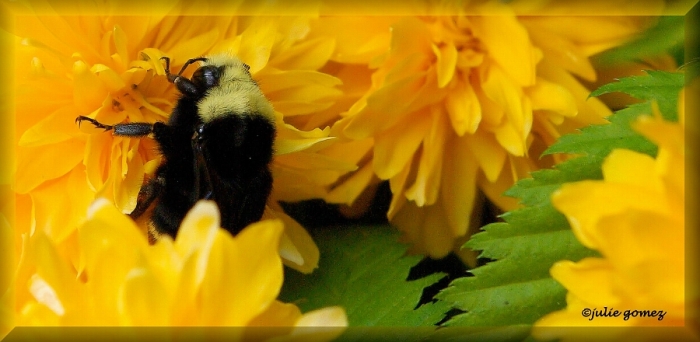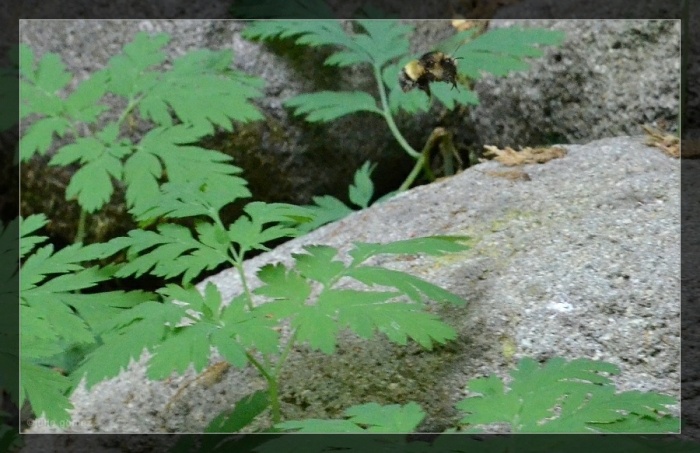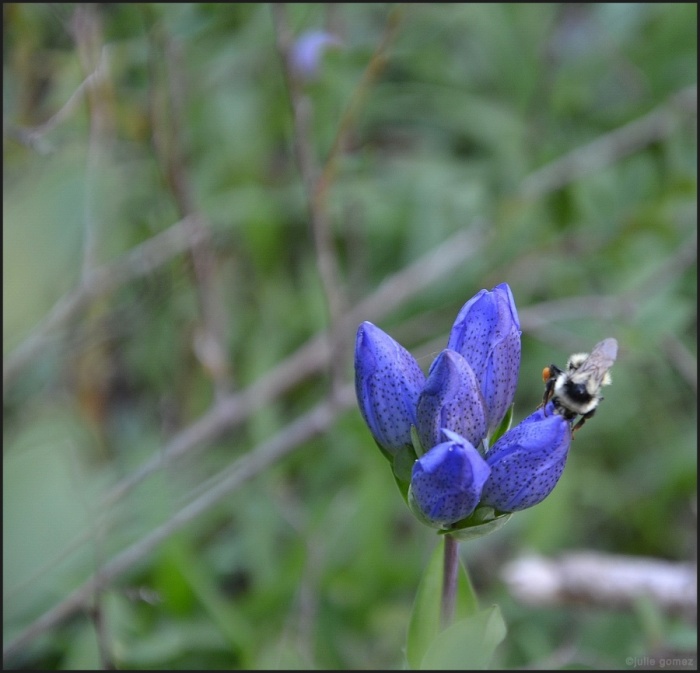
“Aerodynamically, the bumblebee shouldn’t be able to fly, but the bumblebee doesn’t know it so it goes on flying anyway.” —Mary Kay Ash (1918-2001)
🌿 🌿 🌿
I enjoy all wild things, but if I must keep company with things that buzz and sting, such as yellow jackets, hornets, or bumblebees, I’ll choose bumblebees. Bumblebees, unless provoked, are passive creatures that are content to feast on nectar and gather pollen to fill their “little baskets” located on the tibia of the hind legs.
Only mated queens survive the winter. In spring, as the weather warms, the queen becomes restless. Having slept away the winter months in an abandoned rodent den or bird’s nest, she emerges hungry as a bear. If she is an urban bumblebee, she will likely be greeted with a profuse supply of garden flowers. In the wild, however, she might find bee fodder more or less scanty.
If nectar and pollen are scarce, the queen becomes inquisitive. Be it animal or human, she will buzz and circle. She might circle a few times, or dozens of times, wide circles at first, but drawing closer with each pass. Curious to what would result, I decided not to run, and crouched down. As expected, the bumble started circling. Her buzz was loud and strong. Each circle brought her closer. Keeping still despite my nerves, and the want to flee and flail my arms, I started counting the circles. On the ninth pass, and just six inches away, she lost interest, and flew away—whew!
I grew up in the city, and so I was well acquainted with what us kids called the black and yellow bumblebee. A large, fuzzy bumble known to science as Bombus vosnesenskii, commonly called yellow-faced bumblebee, or Vosnesenskii bumblebee—now that’s a mouthful!
The yellow-faced bumblebee inhabits the West Coast, and Nevada. The peak months for seeing queen yellow-faced bumbles are June, July, and August. This is the most common bumble of urban areas, and is often seen foraging on flowers of white clover and dandelion. I remember as a kid playing barefoot in the yard, and can attest to more than one bumble stinger in the bottoms of my feet. Perhaps that’s why today I seldom go barefoot.
Stingers in the bottoms of my feet were not my only bumble mishaps. Once while staying at my grandmother’s farm, a yellow-faced bumble struck the back of my head and was instantly trapped in my long blonde hair. The bumble squirmed and buzzed with a vengeance. The more she struggled, the more entangled she became. I was petrified! Grandmother took immediate action. Instructing me to keep still, she hurried inside the house and returned with a can of hairspray. Now, Grandmother was a country gal and liked wearing those big full hairdos, so the spray was probably extra hold. Grandmother doused the bumble until its buzz went silent. Thanks to Grandmothers quick thinking I wasn’t stung.

When spending time outdoors, bee encounters are bound to happen. It was our seventh spring as mountain dwellers that I met Tank. While I’m not in the habit of giving names to bumblebees, Tank was different.
Tank was an oversized queen, a mixed bumblebee, Bombus mixtus. Typically a small woodland species, the mixed bumblebee occurs from Alaska south along the West Coast, and east to the Colorado Rockies. The mixed bumblebee, also called fuzzy-horned bumblebee, has short hairs of various colors that range from beige to brown, to yellow and red that are blended with fine black hairs. According to Bumble Bees of the Western United States, Bombus mixtus queens can emerge as early as March, with peak times being April and May.
While out in the woods one sunny day in early March, I heard the biggest buzz. When I turned to look, that’s when I saw Tank. I was awestruck! Of all the mixed bumblebees I’ve ever seen none were bigger than my thumbnail, but Tank was the exception. Almost as big as my thumb, she looked like a barrel with legs that jutted from the sides. Her flight was slow and staggering. Her undersized wings could barely carry her.
Tanks buzz matched her size. I could always hear her long before I could see her, even if at opposite ends of the yard. Once, she tried to give chase, but she hadn’t the power or the agility to make good on it. Because of her sluggish flight, there was always time to get out of her way. Tank buzzed our woods for two more summers, and then we never saw her again. Each spring, I think of Tank. She was an incredible bumble, a one of a kind, and there has never been another one like her since.
____________________
Copyright 2013. All rights reserved.
🌿 A good book on insect identification is Insects of the Pacific Northwest by Peter Haggard & Judy Haggard

